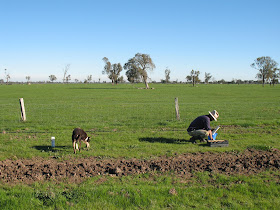 |
| Planting Buloke trees on the heavily cleared Wimmera plains of western Victoria. (Photo: John Morgan) |
The two most common explanations that are used to justify / defend this approach are that (i) local seed produces plants that are best adapted to the revegetation site (the 'local adaptation' hypothesis) and (ii) using local seed reduces the risk of causing outbreeding depression (i.e. the introduction of novel genes that will swamp the local genotype). I, too, have tended to use these concepts to underpin my thinking on this issue. But, on reflection, I've started to change my mind on this, for two reasons.
The first is a fairly simple reason. Temperate grasslands in southern Australia have been reduced by more than 95% and hence, the scale of the restoration problem is enormous. Quite frankly, seed availability will constrain our ability to restore this system and we must think more broadly if we want to meaningfully reverse the decline. This means having to collect seed from a wider area (there are simply too few remnants nearby to supply seeds in this severely fragmented landscape) and creating seed orchards to rapidly bulk up seed numbers. Additionally, I have a bit of an ethical dilemma with sourcing local seed off tiny populations; this probably imperils their capacity to survive in the future, and I have grave concerns about this as indirect (maybe even direct) cause of local population decline.
 |
| Swainsona spp. are now extremely rare in grasslands. (Photo: John Morgan) |
The second reason I've started to change my mind about the imperative of using local provenance stems from new research that I've been following over the last few years. Two papers caught my eye and I think they are worth sharing.
Hancock et al (2012) experimentally test the idea that plants grown from locally-sourced seed have the advantage of being best adapted to local conditions compared to seeds sourced from further away. Using a common garden experiment, they planted six common species native to woodlands near Sydney, Australia (but with broad distributions down the east coast of Australia) and compared survival, growth and flowering for plants sourced from 'near' and 'far' from the planting sites. After both 7 and 24 months, they found very little evidence that local provenance plants were superior to distant provenances in terms of survival and establishment. Hence, there was little evidence to support the use of local seed, perhaps because these are widespread species with genetically-connected populations. Such an outcome might also relate to the grasslands of southern Australia that were once extensive, connected, and spanned relatively similar climates and soils. Local adaptation is more likely to be important when a species occurs across a strong environmental gradient (such as with altitude). Locally-sourced seed is likely a much more important concept under these circumstances.
Sgro et al (2010) provide a really compelling overview of the concept of building evolutionary resilience into restoration plantings, and why locally collected seed might do more long-term harm than good in the face of rapid climate change. I recommend you read this paper if you are interested in the role of genetics, evolution and adaptation in restoration. It is certainly thought-provoking and one of the most interesting papers I have read this year. You may not agree with it, but it'll certainly challenge you.
A couple of things caught my eye about their paper. Cutting and pasting the crux of the matter, Sgro et al. suggest that:
"The long-term aim of genetic translocations (i.e. use of non-local provenance) is to create populations that harbour the adaptive genetic diversity to enable ongoing adaptation to the environmental changes caused by climate change and other threats. This helps to obviate the need for ongoing intervention and management, ensuring evolutionary resilient populations."
"A ‘local is best’ sourcing practice misses two important points, which may seriously impact restoration or reintroduction outcomes in the face of future climatic changes. The first potential problem with ‘local is best’ recommendations is that there is a risk of encouraging the establishment of populations that do not harbour sufficient genetic variation and evolutionary potential [i.e. establish genetic ghettos]. In addition, strict adherence to ‘local is best’ protocols may encourage the selection of inbred or genetically depauperate seed sources, when genetically healthier sources further afield may produce a more efficacious restoration result. This may serve to perpetuate the number of small inbred populations across highly degraded landscapes that are unlikely to persist in the long term."
Sgro et al. (2010) then provide an interesting recommendation for seed collection protocols to preserve evolutionary resilience by focusing on 'composite provenancing' - the idea that a small amount of seed from distant sources should be included in seed mixes (comprising mostly local seeds) to enhance gene flow that may bring in additional adaptive or beneficial genes.
 |
Recommendations for provenancing based on dispersal distance from parental plant (Figure 3 from Sgro et al. 2010)
|
At some levels, this type of discussion makes me think long and hard about what is important regarding conservation of highly modified native ecosystems such as grasslands. Saving the components of the ecosystems (their species) has to assume the highest priority, and if this requires genetic translocations, assisted migrations, and challenging long-held ideas about local provenance, then I am open to this idea. What about you?
References
Hancock, N., Leishman, M.R. and Hughes, L. (2012) Testing the 'local provenance' paradigm: a common garden experiment in Cumberland Plain woodland, Sydney, Australia. Restoration Ecology doi: 10.1111/j.1526-100X.2012.00931.x
Sgro, C.M., Lowe, A.J. and Hoffmann, A.A. (2010) Building evolutionary resilience for conserving biodiversity under climate change. Evolutionary Applications 4, 326-337.